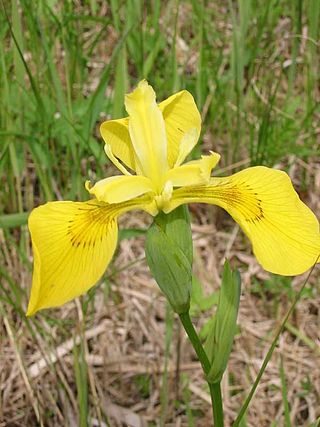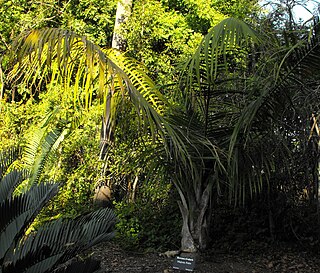
Iridaceae is a family of plants in order Asparagales, taking its name from the irises, meaning rainbow, referring to its many colours. There are 66 accepted genera with a total of c. 2244 species worldwide. It includes a number of other well known cultivated plants, such as freesias, gladioli and crocuses.

The water-plantains (Alismataceae) are a family of flowering plants, comprising 19 genera and 117 species. The family has a cosmopolitan distribution, with the greatest number of species in temperate regions of the Northern Hemisphere. Most of the species are herbaceous aquatic plants growing in marshes and ponds.

Crocosmia (;), also known as montbretia, is a small genus of flowering plants in the iris family, Iridaceae. It is native to the grasslands of southern and eastern Africa, ranging from South Africa to Sudan. One species is endemic to Madagascar.

Ravenea is a genus of 20 known species of palms, all native to Madagascar and the Comoros.

Dipterostemon is a monotypic genus of flowering plants in the family Asparagaceae. Its only species is Dipterostemon capitatus, synonym Dichelostemma capitatum, known by the common names blue dicks, purplehead and brodiaea, native to the Western United States and northwest Mexico.

Amorphophallus paeoniifolius, the elephant foot yam or whitespot giant arum, is a tropical plant native to Island Southeast Asia. It is cultivated for its edible tubers in Southeast Asia, South Asia, Madagascar, New Guinea, and the Pacific islands. Because of its production potential and popularity as a vegetable in various cuisines, it can be raised as a cash crop.

Latania, commonly known as latan palm or latania palm, is a genus of flowering plant in the palm tree family, native to the Mascarene Islands in the western Indian Ocean.

Phoenicophorium, the thief palm, is a monotypic genus of flowering plant in the family Arecaceae. The sole species is Phoenicophorium borsigianum.

Peperomia graveolens is a species of plant in the genus Peperomia of the family Piperaceae. It is endemic to Ecuador.

Dierama is a genus of flowering plants in the family Iridaceae. Common names include hairbells, angel's fishing rod, fairybells, and wandflowers in English and grasklokkies in Afrikaans. They are native to Africa, with most occurring in the southern regions of the continent. The center of diversity is the province of KwaZulu-Natal in eastern South Africa.

Callopsis is a monotypic genus from the plant family Araceae and has only one species, Callopsis volkensii. This plant forms a creeping rhizome and has cordate-ovate leaves that are medium green and glaborous. The inflorescence is typical of the family Araceae, with a white spathe and yellow spadix. The spadix is shorter than the spathe and its male and female flowers are separated shortly.

Ambrosina is a genus in the family Araceae that consists of only one species, Ambrosina bassii, and the only genus in the tribe Ambrosineae. This species is the smallest aroid in the Mediterranean, growing only to 8 cm tall. It is usually found growing in woodlands on north faces of hillsides and in humus soil that is covering limestone. It is distributed in Sardinia, Corsica, Sicily, southern mainland Italy, Tunisia, and Algeria.

Dudleya variegata is a deciduous succulent plant in the family Crassulaceae known by the common names variegated liveforever, variegated dudleya or rarely San Diego Hasseanthus. A cryptic plant that survives part of the year dormant underground from starch reserves in a corm, after sufficient rainfall, leaves will emerge, soon giving way to small inflorescences with yellow star-shaped flowers. It is native to Baja California and adjacent San Diego County in California, where it grows in several habitat types, including chaparral and vernal pools.

Odontostomum is a monotypic genus of flowering plants containing the single species Odontostomum hartwegii, which is known by the common name Hartweg's doll's-lily. In the APG III classification system, it is placed in the family Tecophilaeaceae. It was formerly placed in the Liliaceae. It This wildflower is endemic to northern California, where it can be found in the inner coastal mountain ranges and the Sierra Nevada foothills. It grows in rocky clay and often serpentine soils in grassland and woodland habitat, sometimes near vernal pools. This is a perennial herb growing from an oval-shaped corm up to 3 centimeters wide deep in the soil. The curving, widely branching stem is up to about half a meter in maximum height with linear leaves up to 30 centimeters long sheathing the lower portion. The inflorescence is a raceme or panicle of several flowers on pedicels. Each flower has six white or yellowish tepals, the lower parts fused into a veined tube and the tips spreading and then becoming reflexed. At the center of the flower are six stamens and six staminodes in a ring around the gynoecium.

Alisma subcordatum, the American water plantain, is a perennial aquatic plant in the water-plantain family (Alismataceae). This plant grows to about 3 feet in height with lance to oval shaped leaves rising from bulbous corms with fibrous roots. Any leaves that form underwater are weak and quick to rot; they rarely remain on adult plants. A branched inflorescence with white to pink 3-petaled flowers blooms from June to September. The seeds are eaten by waterfowl and upland birds. Native Americans dried and ate the submerged rootlike structures. The species name subcordatum means "almost heart-shaped".

Watsonia meriana is a species of flowering plant in the family Iridaceae known by the common name bulbil bugle-lily. It is one of several Watsonia species known as wild watsonia. It is native to the Cape Provinces of South Africa, but it is well known as an ornamental plant grown in gardens for its showy spikes of flowers, and is an invasive species in areas where it has escaped cultivation.

Crocosmia aurea, common names falling stars, Valentine flower, or montbretia, is a perennial flowering plant belonging to the family Iridaceae.

Cyanastrum is a genus of plants in the family Tecophilaeaceae, native to tropical Africa. It contains three currently recognized species.

Crocus ochroleucus is species of flowering plant in the Iridaceae family. It is a cream-colored crocus native to Lebanon, Palestine and Syria.

Crocus baytopiorum is a species of flowering plant in the genus Crocus of the family Iridaceae. It is a cormous perennial native to Turkey.



















